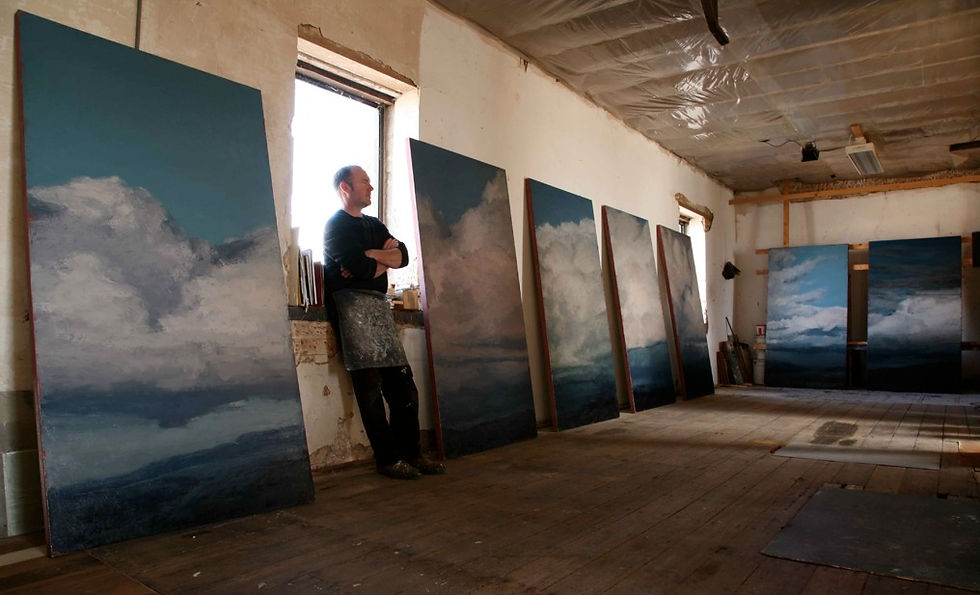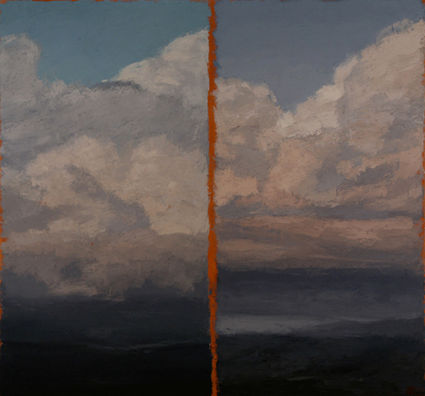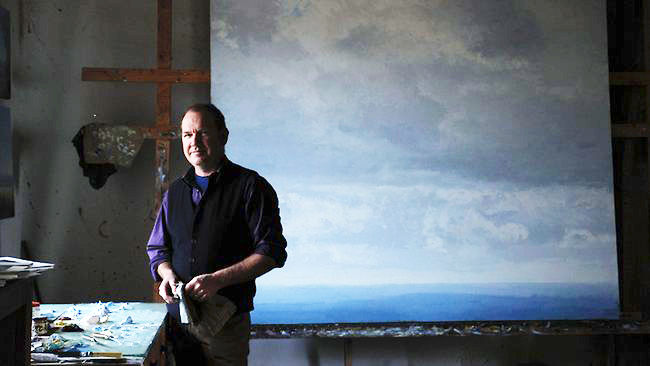The journey out and beyond: Loss, grief and solace in the landscapes of Philip Wolfhagen
- Andrew McIlroy
- Jul 24, 2018
- 4 min read

There is a sense in Philip Wolfhagen’s blustery, heaving landscape paintings that something has changed for the worse. Here the awesome forces of nature are to be admired and feared. In such a hostile and ever-changing terrain, with its dramatic shifting light and breaking atmosphere, nothing can be taken for granted for long.
But Wolfhagen’s ‘stay at home’ assignation with the Tasmanian landscape runs deeper. For him the connection is personal – emotional as well as physical.
Created by a process of mixing beeswax with colour pigments, the luscious tactile surface of Wolfhagen’s paintings are indeed expressive of the close relationship he shares with his environment.

Philip Wolfhagen, 'New Delirium' 2007 Photo: Dominik Mersch Gallery
But over the past decade I have noticed an emotional shift in Wolfhagen’s work. A kind of lament, a soulfulness sweeping across the canvases, unanchoring me. Standing amongst the paintings of his survey exhibition at The Tasmanian Museum and Art Gallery in 2013, I felt isolated, adrift in the waves of his key works and unsure of how to process what I was experiencing. An answer was it seems not too far away.
On 27 September this year, Wolfhagen’s new solo exhibition, ‘Elegies’ opens at Dominik Mersch Gallery in Sydney – with the works previewing at Sydney Contemporary at Sydney’s Carriage Works. The answer to my feeling of being bereft is found then in part in the title of Wolfhagen’s new body of work.
An elegy is a poem of serious reflection, typically a lament for the dead. This artistic device has a long lineage. Originating as ancient Greek metrical form, traditionally written in response to the death of a person or group as an alternative to memorial or grave art, it was notably later represented in art by the elegiac pastoral and romantic ruin paintings of the sixteenth and seventeenth centuries through to twentieth century images that combine grief with anger relating to the mass brutalities of war or the holocaust – the latter mourning too reflecting the inadequacies of traditional elegy faced with these modern forms of death. (Elizabeth Helsinger, ‘Grieving images: Elegy and the Visual Arts’, The Oxford Handbook of Elegy, OUP 2010)

Philip Wolfhagen, 'Night Beacon VI' 2005 Photo: Philip Wolfhagen
The elements of a traditional poetical elegy mirror three stages of loss. First, there is a lament, where the speaker expresses grief and sorrow, then praise and admiration of the idealised dead, and finally consolation and solace. Many modern elegies have been written not out of a sense of personal grief, but rather a broad feeling of loss and metaphysical sadness. Adding the immediacy of painting is a resource that can make silent images sharpen attention to the most subtle as to the most extreme forms of feeling. (Helsinger)
Wolfhagen’s paintings laid out before me in his 2017 exhibition, ‘Hinterland’ at Hobart’s Betts Gallery imbued a sense of sorrow and feelings of helplessness and even grief. My grief was for the ecological loss strewn before me. I became aware at that moment of the impact of climate change on our lives, livelihoods and culture and the implications for mental and emotional well-being.

Philip Wolfhagen, 'Hinterland No. 1' 2017 Photo: Philip Wolfhagen

Philip Wolfhagen, 'Hinterland No. 4' 2017 Photo: Philip Wolfhagen
For indigenous peoples the land is everything. It is family, kin, history, heritage and culture. It is a place to refresh and heal. It is a place of reverence and respect. It is a place where human bonds are forged and strengthened, where children grow and families flourish.
For people and a culture relying so intimately and directly on the environment in all aspects of life, any shift however subtle can have lasting impacts on individuals, families and communities – physically, mentally, emotionally and spiritually.
Wolfhagen’s landscapes evoke feelings of despair and hope. For the viewer it is an altering moment, a catharsis of sorts. They leave one feeling both weak and empowered.
I realised here the deep importance of understanding, experiencing and thinking about ecological loss, of grief and mourning, and the power that comes from having a deep connection to the land in such a way as to leave you completely vulnerable.

Phillip Wolfhagen, 'The Serpentine Path' 2015 Photo: Philip Wolfhagen

Philip Wolfhagen, 'Fourth Transect' 2017 Photo: Philip Wolfhagen
In Wolfhagen’s paintings I feel the deep sense of bereavement. It is just that in this, there is no-one about me to tell. There is no-one to share the mourning and provide comfort or solace. There was no memorialising, as when the death of a loved one occurs. All that remains is the pain and the daily realisation of human and ecological suffering.
There is ultimately but one way forward. To recognise, respect and pay homage to the mourning process, confront the loss and embrace it, to understand the terrain well enough to journey out and beyond.
Wolfhagen is a talented and influential painter. His paintings are as much an ecological elegy and eulogy as they are philosophical and intellectual. They are about loss of place. A loss that is both literal in that the landscapes and ecosystems around us are changing, and psycho-social because on a deeper level they can make you feel that we are losing our place in the world, that we are lost as to how to stem the destruction, heal the wounds and make amends. Our grieving is persistent but must in the end spur us on to act.
'Elegies', new paintings by Philip Wolfhagen runs from 27 September to 29 October 2018 at Dominik Mersch Gallery, Sydney
Main Photo: Philip Wolfhagen 2007 Photo: Philip Wolfhagen
Andew McIlroy is a visual artist and arts writer, living and working in Melbourne, Australia

Phillip Wolfhagen 2017 Photo: Bett Gallery

Philip Wolfhagen, 'Drawing The Light In II' 2008 Photo: Bett Gallery

Philip Wolfhagen, 'Surface Tension No. 3' 1998 Photo TMAG



Comments